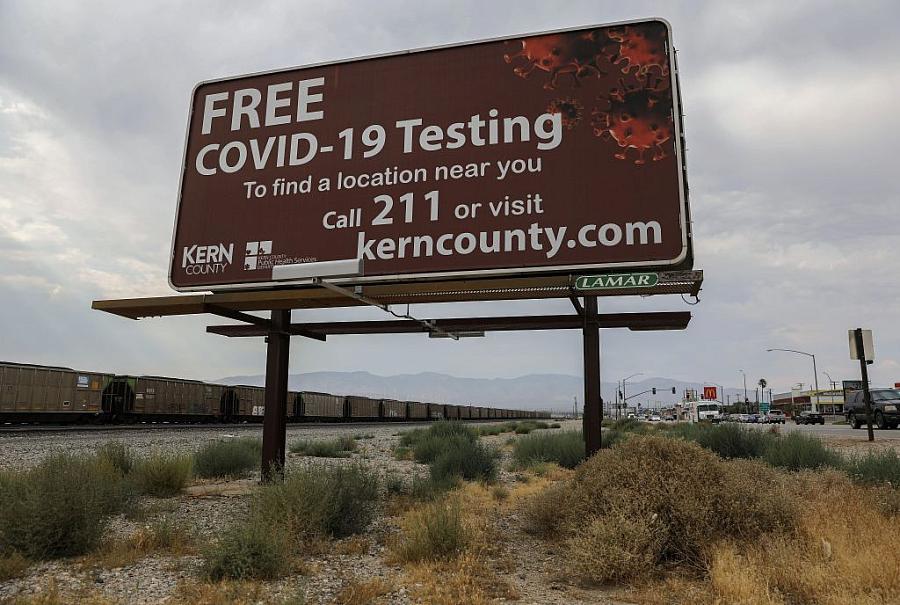Understanding how coronavirus swept through rural California’s Kern County

A billboard displays COVID-19 testing information in in Kern County, which has had one of the highest COVID-19 infection rates by county in California.
(Photo by Mario Tama/Getty Images)
In the summer of 2020, COVID-19 swept rampantly through Kern County, the southernmost county in California’s agricultural heartland, a region once referred to as the Appalachia of California for its entrenched socioeconomic challenges. Yet as the dust begins to settle on the coronavirus crisis here, it remains unclear how a county that ranks 11th among California counties in population ended up with the second-highest COVID-19 case rate per capita in the state.
When asked, experts typically guess at a number of reasons for the rapid transmission here. The county’s agricultural base relies heavily on an immigrant workforce. Kern County is also home to five state prisons and 19 nursing homes, nearly all of which were hit with COVID-19 outbreaks. Metropolitan Bakersfield is rife with poverty, poor access to health care, low educational attainment, crime and consistently scores low on a number of statewide health indicators. The county skews right politically and that has influenced local leaders’ approach to the pandemic. Two doctors here famously held a press conference that went viral calling for reopening; county supervisors and local state legislators heavily pressured the state’s Democratic governor to let the county reopen; and local authorities and public health officials have been hands-off with enforcing state shutdown orders and social distancing.
Did all these factors contribute to the COVID-19 crisis in Kern? Some more than others? What can be learned from this tragedy going forward?
One way to answer these questions would be to look closely at who contracted the virus and who died. Unfortunately, local public health officials have refused to be transparent in this area. What little data has been released on cases and deaths is so disaggregated it’s hard to draw any conclusions from it.
My reporting project for the 2020 Data Fellowship seeks to reach answers to these questions in a different way: By using publicly available case data and joining it with data from the census, county elections office, the Bureau of Labor Statistics and other datasets to illuminate unique characteristics of Kern County that made it so conducive to widespread viral transmission. This analysis, to be published in The Bakersfield Californian, would not only zero in on local hotspots and provide greater understanding of where the virus spread most and why, but would also compare how Kern County stacks up with other counties in the state and what made it so vulnerable to the coronavirus.
Nearly 40,000 people have been infected with COVID-19 in Kern and 432 people have died. For the most part, who they are remains a mystery.
Some clues do exist as to who may be most impacted by the virus. My reporting so far has shown that rural, farmworker communities, many of which are heavily Hispanic and low-income, have some of the highest concentrations of COVID-19. This would seem to suggest that farmworkers and those who work in the processing facilities that support the county’s billion- dollar agriculture industry have been hard hit. There are also anecdotes to back this up. The head physician for a clinic serving one of these communities has verified that COVID-19 test positivity rates at the clinic have consistently been above 30%.
Kern County is a large diverse county made up of many different communities and not all were impacted equally. Ridgecgrest, in the eastern Kern desert, which was rocked by an earthquake in 2019, has seen relatively low rates of COVID-19, as have many small communities in the foothills. Other communities have high rates of COVID-19 but are also home to state prisons that saw major outbreaks of the virus.
If it is primarily a poor, immigrant workforce that has been impacted by COVID-19, this raises questions of equity and ethics in how we treat society’s most vulnerable, who are the backbone of the region’s agriculture industry. What was done to try to protect this population and was it enough?
It also raises questions about how disparate living conditions and health conditions in pockets of a county can ultimately impact the entire county as a whole.
Examining these critical issues can help local leaders and policy makers better understand how we can prevent or improve the response to future crises in our community. To move on from the COVID-19 crisis without making an effort to understand who was affected, who fell ill, who died, and why would certainly be a missed opportunity.

